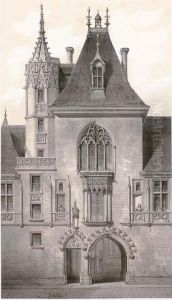Victor Petit Paintings
Victor Petit was a French artist, engraver, and lithographer known for his detailed architectural and landscape drawings. Born in 1817, he emerged in a period rich with artistic evolution in France, navigating the transitions from Neoclassicism to Romanticism, and eventually to Realism. Although not as widely recognized as some of his contemporaries, Petit's work provides a valuable glimpse into the architectural heritage and scenic landscapes of 19th-century France, making significant contributions to the documentation of French heritage.
Petit's artistic journey was marked by his fascination with architecture and landscapes, elements that would define his career. He meticulously captured the essence of French châteaux, historic buildings, and picturesque landscapes. His lithographs, characterized by their attention to detail and accuracy, served not only as works of art but also as historical documents that preserved the appearance of many locations and buildings that have since been altered or destroyed.
During his lifetime, Victor Petit published several albums and collections of lithographs. Among his notable works were series that focused on the architectural beauties of France, including 'Les Châteaux Historiques' (Historical Castles) and 'France Monumentale et Pittoresque' (Monumental and Picturesque France). These publications were well-received, appealing to both the artistic community and the burgeoning class of cultural tourists of the time.
Despite his contributions, Petit's name remains relatively obscure in the broader history of art. His work did not push the boundaries of artistic innovation in the way that Impressionism or Post-Impressionism did shortly after his death in 1871. Instead, Victor Petit's legacy lies in his role as a chronicler of his time, capturing the beauty and detail of French architecture and landscapes with a meticulous and loving eye. His lithographs continue to be appreciated by collectors and historians for their beauty and historical value, offering a window into the France of the 19th century.
